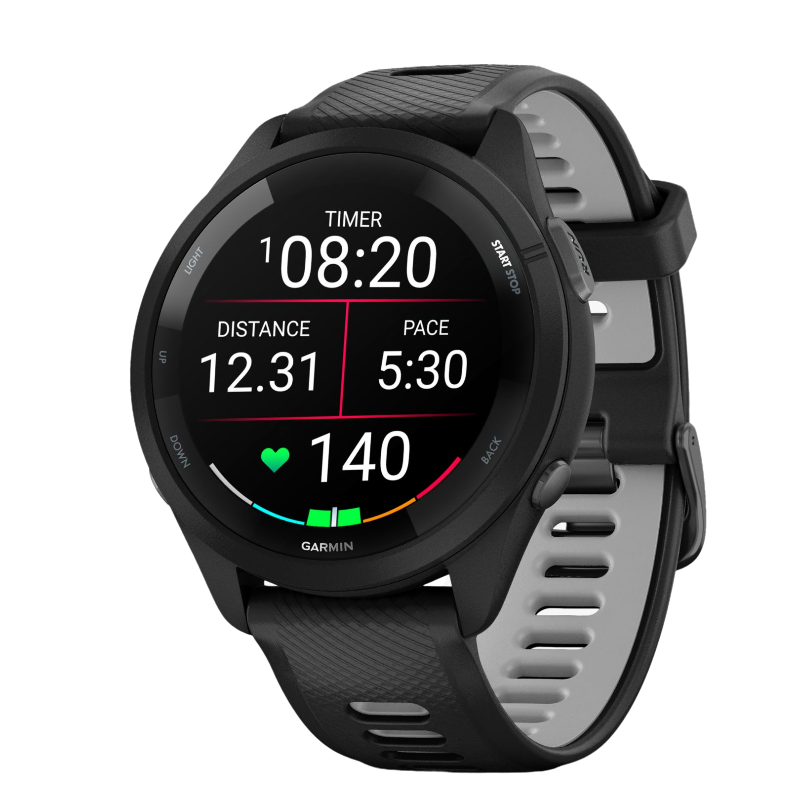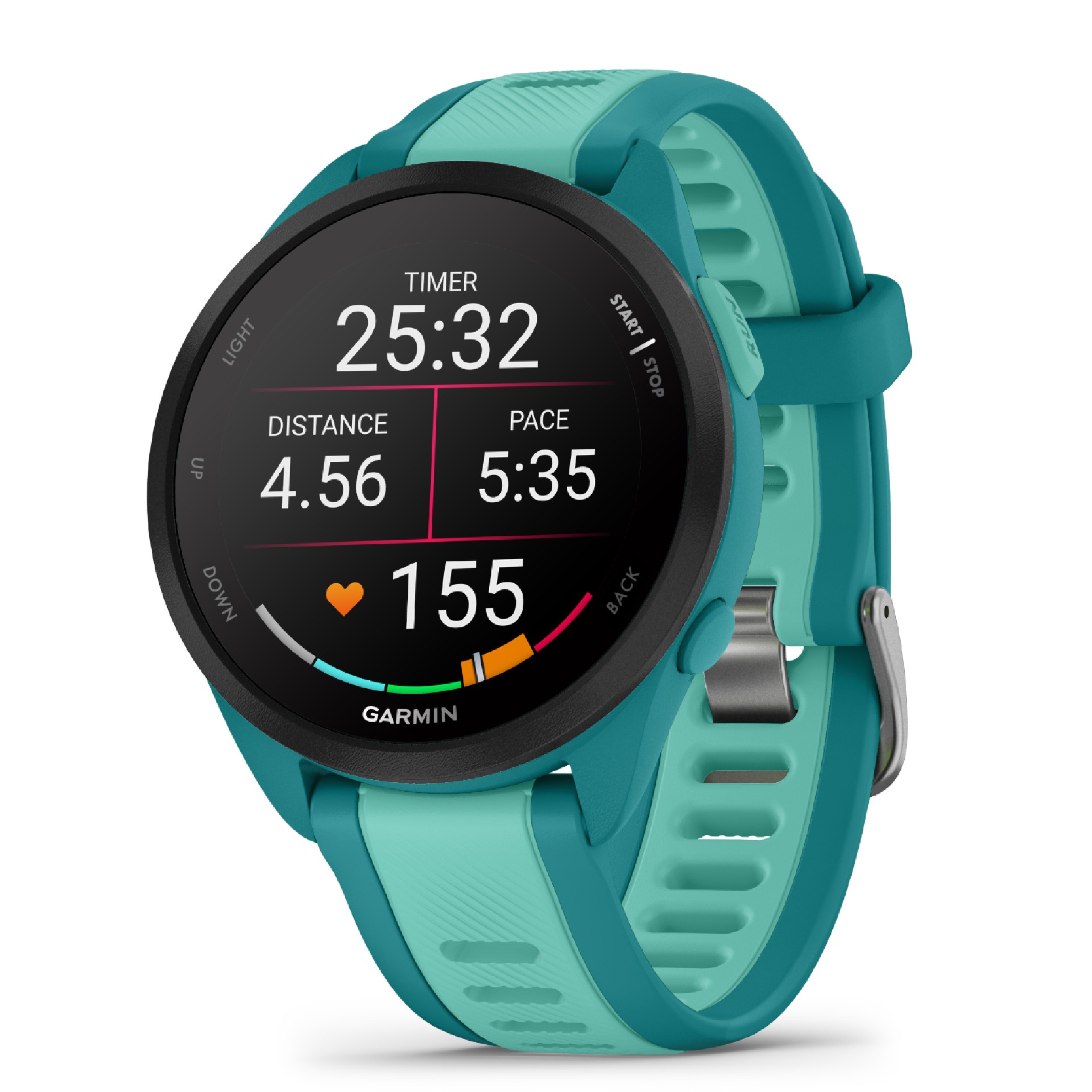Garmin Forerunner 265 Vs Garmin Forerunner 165: Which AMOLED Sports Watch Should You Get?
The Garmin Forerunner 165 and Garmin Forerunner 265 are excellent sports watches, but triathletes in particular should upgrade to the 265

My pick as the best overall sports watch, the Forerunner 265 is a multisport watch with an attractive, lightweight design. It has more features than the Forerunner 165, including dual-band GPS, more training analysis, cycling power meter support and a triathlon mode.
Pros
- Multisport mode
- Dual-band GPS
- Two sizes
- More training analysis
Cons
- More expensive than Forerunner 165

The Garmin Forerunner 165 is one of the best running watches and, while it doesn’t have all the bells and whistles you get on the Forerunner 265, if you don’t need those extra features you’re still getting a capable watch at a lower price.
Pros
- Cheaper than Forerunner 265
- Lightweight design
- Accurate tracking
- Same smart features as 265 (165 Music)
Cons
- Not a multisport watch
- Limited training analysis
The Garmin Forerunner 165 and Garmin Forerunner 265 are among the best sports watches. Both have bright AMOLED screens and offer accurate tracking and insightful training analysis. You get more features with the Forerunner 265, which is a full triathlon watch, but the Forerunner 165 represents better value for runners.
Garmin Forerunner 265 vs Garmin Forerunner 165: Price And Availability
The Garmin Forerunner 265 launched in March 2023 and costs $449.99 in the US and £429.99 in the UK. There are two sizes available—the standard Forerunner 265 and smaller Forerunner 265S—but both have the same features and price.
The Garmin Forerunner 165 launched in February 2024 and there are two models: one with music, one without. The standard Garmin Forerunner 165 is $249.99/£249.99 and the Garmin Forerunner 165 Music is $299.99/£289.99.
How I Tested These Watches
You can trust Coach
I tested the standard Forerunner 265 and Forerunner 165 Music for our full reviews, using both for several weeks to track my training and daily activity. I usually run 50-70 miles a week and have also done yoga and strength sessions with both watches. To test GPS and HR accuracy I used each watch at the same time as the Garmin Epix Pro (which I’ve found accurate for GPS) linked to a Polar H10 chest strap, which I consider one of the best heart rate monitors.
Design
The Forerunner 265 and Forerunner 165 have similar designs, with a plastic case, five buttons and AMOLED touchscreens. The Forerunner 265 uses more durable Gorilla glass for its screen, whereas the 165 has chemically strengthened glass. The Forerunner 265 comes in two sizes: The 265S has a 1.1in screen and the 265 a 1.3in screen. The Forerunner 165 only comes in one size, with a 1.2in screen.
Both watches have barometric altimeters and Garmin’s Elevate V4 optical heart rate sensor. There’s no major difference between the internal sensors, and both link to external sensors via both Bluetooth and ANT+. However, the Forerunner 265 can link to cycling power meters where the Forerunner 165 can’t, which marks the latter as more of a running watch than a multisport one.
Sports Tracking And Training Analysis
The main difference with the sports tracking on the two watches is that the Forerunner 265 has a multisport mode, whereas the 165 doesn’t. You can track all the individual sports of a triathlon with the 165, including open-water swimming, but it doesn’t have the multisport mode.
During activities the Forerunner 265 can display more data fields at a time than the 165; there’s a maximum of six on the 265 and four on the 165. Both are clear and easy to read during activities, even in sunny conditions.
There are more differences between the training analysis offered by the watches. The Forerunner 265 provides Garmin’s training status insights (which tell you if your training is proving productive or not) and a training readiness score that rates how ready you are to train. This is out of 100, and based on factors like sleep, training history and heart rate variability (HRV) overnight.
The Forerunner 165 provides a more basic experience, though it does give your HRV status overnight, as well as estimating your VO2 max and race times. It also advises you on how long it will take to recover after a workout.
At times, the more extensive training analysis on the Forerunner 265 is useful, but it’s the multisport features that are probably more important in determining which is the right choice for you.
GPS And HR Accuracy
The Forerunner 265 has dual-band GPS, which is the most accurate option, whereas the Forerunner 165 has only all-systems-on GPS. I say “only” but all-systems-on is still accurate—and during my testing of the 165, the distance tracking matched up well to the stats from the Garmin Epix Pro in dual-band mode. You still get an improvement with the dual-band on the 265, especially when running amid tall buildings in cities, but it reduces battery life to use the dual-band mode.
Both watches have the same optical heart rate sensor and I experienced mixed results with its accuracy during testing. If you want the most accurate results, pair one of the best heart rate monitors with either the Forerunner 165 or 265. If you intend on using the training analysis on either watch, using a chest strap is advisable because this will help avoid poor data coming into the watch from workouts where the optical sensor has proved inaccurate.
Battery Life
The longest-lasting watch in the Forerunner 165 and 265 ranges is the Forerunner 265S. Overall, the differences in battery life between the Forerunner 165 and 265 are not big enough to make it a significant factor, but the 265 lasts longer between charges. Both lasted around four or five days for me with the screen set to always-on, tracking runs every day, though listening to music via the watch brings that number down quickly.
| Row 0 - Cell 0 | Garmin Forerunner 165 | Garmin Forerunner 265S | Garmin Forerunner 265 |
| Watch mode | Up to 11 days | 15 days (5 days always-on) | 13 days (5 days always-on) |
| GPS Battery Life (all-systems-on) | 19 hours | Not given | Not given |
| GPS Battery Life (multi-band) | N/A | 15 hours | 14 hours |
More Garmin Forerunner 265 Versus
Sign up for workout ideas, training advice, reviews of the latest gear and more.

Nick Harris-Fry is a journalist who has been covering health and fitness since 2015. Nick is an avid runner, covering 70-110km a week, which gives him ample opportunity to test a wide range of running shoes and running gear. He is also the chief tester for fitness trackers and running watches, treadmills and exercise bikes, and workout headphones.
